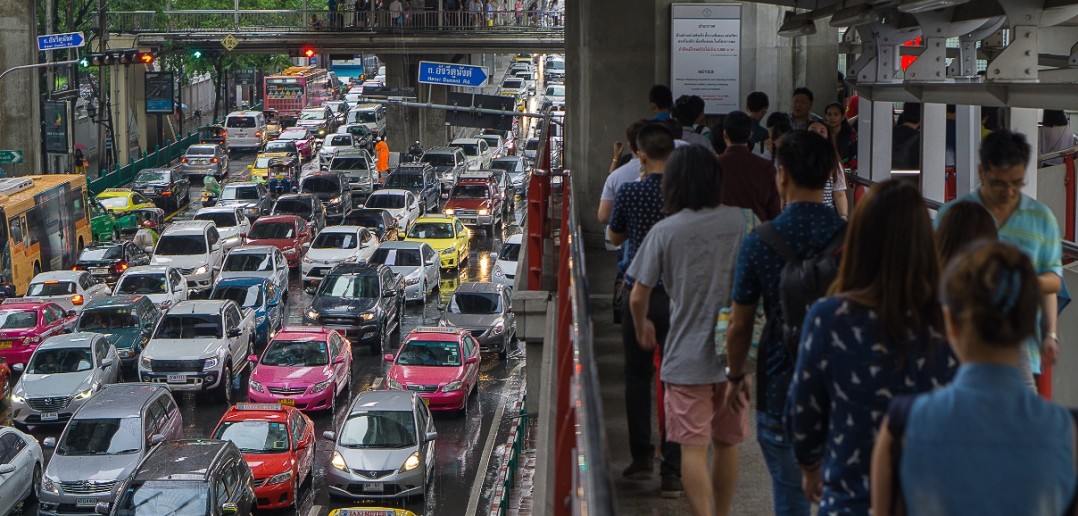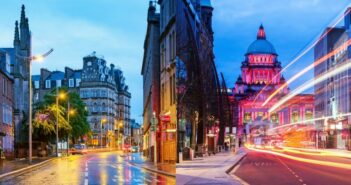City hubs – a proposal for ultra-high-density living
Of course, we cannot truly recover time lost to commuting in the past. But we can examine contemporary global cities where development patterns currently under way can be coaxed toward recovering that time for future generations.
Despite its charms, London is an inconvenient city to live and work in, requiring residents to spend much time in transit, which cuts into the quality of life in an already very expensive city. Hong Kong is by no means inexpensive, but it is a comparatively convenient high-density city. In Hong Kong, the prevalent notion, reinforced by its physical geography, is that city life does not have to be inconvenient. In the 1980s Hong Kong grew massively, but it did not “sprawl” in the traditional sense of the word. Instead it developed high-density secondary new towns outside of its central business district on Hong Kong Island, which helped maintain short journey times for a substantial portion of its citizens. In the 1990s, Singapore also grew in a similar way.

Maintaining the Value of Your Real Estate in the Post-Pandemic World
Today, in mainland China, rapidly growing cities are experiencing high levels of congestion and travel difficulties. Observing how Asian cities have developed over the last 30 years, it is reasonable to predict that Chinese cities will solve this problem first, by developing a concept similar to new towns which I call secondary hubs.
Same City, Different Dweller Demands
As city dwellers, our lives change quickly. We live in compact apartments, exercise in gyms rather than parks, and have a huge variety of entertainment and recreation options. Social media enables us to meet and to travel quickly and conveniently. In fact, our entire lives have become faster and more convenient during our lifetimes.
Meanwhile, our cities are having a hard time adapting to our new demands for flexibility, variety and convenience. It’s serendipitous that China now has the opportunity to create 21st-century cities at this time of great change in our patterns of living, working and recreation.
Five hundred million people have been urbanized in China in the last 20 years, such that now more than 50 percent of Chinese live in cities. About 80 percent of the western world is urbanized. This is a good juncture at which to question what we value in our urban lives. To many, it’s about having a variety of choices: of friends, entertainment, food, jobs, housing and community. Choice allows us to experience happy incidents in our lives.
Most white-collar workers in urban areas have taken the decision to live close to the central business district (CBD) in a small apartment, or in the suburbs in a larger apartment or house. This presents a seemingly binary choice: one must either sacrifice one’s living standards or waste time traveling. Do all our homes have to be so far from our work? Younger people typically want to live right in a core, where there is a high degree of “buzzy” social and cultural activity, nearby to demanding jobs that allow flexibility and the opportunity to walk and avoid long subway or car rides. People with children tend to want to be in the suburbs, near high-quality schools. Upon retirement, many empty-nesters are now choosing to return to center cities, with smaller, more manageable living spaces and good connectivity as physical mobility becomes more of an issue later in life.
Supporters of family — parents or children — will have prioritized space. Single people and young couples you will have prioritized convenience. So why is there such a stark, across-the-board separation of functions in our cities?
In contemporary Shanghai, areas of housing and business are largely completely separated.
Even with Shanghai’s good subway system, it takes an average of 1.5 hours to go to work.
That’s three hours a day, or 20 percent of the working day wasted on travel. This unpleasant figure becomes stunningly huge when considered this way: if our working lives are on average 45 years long, then we will have wasted 3.5 years of our lives traveling to work.
So how can our future cities provide a modern, convenient, connected, and sustainable environment? People who want to live in the city centre and fully experience the buzz and connectivity of the city have completely different demands from those who want to live further away with more space. The inner city dwellers want small apartments mixed in with office, retail and entertainment facilities.
The market has attempted to respond to this in several very interesting ways recently. Residential and serviced apartments, small office / home offices (SOHOs), lofts, hotels, shopping centers and corporate offices can now be found clustered together into single developments. These are not usually “mega-developments,” but they are live-work developments, and they do point toward a new way of life.
From CBDs to City Hubs
Demand for ultra-connected live-work environments will lead to additional CBDs being formed around the original CBD. This super-concentration of secondary CBDs or “City Hubs” will draw people out of the suburbs and lower the suburban density. These hubs will provide the buildings and environment for the ultra-efficient, convenient and connected lifestyle that young citizens now require. Around the hubs, the rest of the city can be developed to a lower density, with parks and greenery. The number of journeys to work, the level of pollution, and the incidence and volume of traffic jams will decrease, while open space will increase.
The “buzzy,” ultra-connected, “IT-generation” City Hubs will contain all the buildings and functions for our new urban lifestyle: Apartments, offices, retail and entertainment. The City Hubs will be built over subway station interchanges for the convenience of the residents. Residents will be able to walk to work. The land outside the City Hubs will be for families, filled with parks, community centers and educational facilities. Together, these work as places where all the contemporary ideas of city life are taken to the ultimate level, in a clean and convenient sustainable city.
There are already existing models that support this new way of living in cities. In addition to the aforementioned mixed-use developments, we now have buildings that are “connected” in more than just a computing sense, and on more planes than one. We can have parks in the sky to connect our various buildings and provide residential space. Public rooftops can be created, and some cities can have connected rooftops across buildings. Our buildings are starting to dematerialize, becoming open to the public at all levels.

Maintaining the Value of Your Real Estate in the Post-Pandemic World
Locating the City Hubs
However, we have not yet joined the dots and planned for live / work / recreate developments distributed across the city in a logical and mutually supportive way. In order to plan our cities well we need to predict and encourage the location of city hubs.
The City Hubs need to be located at major transportation intersections, where major rail and road systems come together. These transport systems enable people to move easily in and out of the hub to other cities and hubs.
Shanghai is already growing in this way; this concept simply builds upon an existing trend. The city is surrounded by several elevated ring roads and two major elevated transverse roads, one running north to south and the other east to west. To some degree the subway network mimics this pattern; there is already a ring-shaped subway line that connects with the radial lines. Where rail lines intersect each other and the highway network, we see large-scale developments that could be considered the predecessors of City Hubs. The reason these developments happen in these places is the reason why City Hubs are the next logical step. They are, just as the City Hubs will be, built over major subway and road intersections, because this is where land value and connectivity are highest, and density will be achievable.
Setting the levels
How do we make a City Hub that can accommodate the needs of our new faster, more connected and more convenient lifestyle? A City Hub must be dense, but with all these people, there is just not enough room on the sidewalks and roads at ground level. To accommodate the many people, we need more public space. In order to create this without sacrificing too much valuable real estate, we can open up the ground with sunken courts to allow light into basements. Upper-level bridges can be wide parks, and be located many levels, which will provide dining and entertainment facilities and will be beautifully landscaped.
Design Considerations
Cities have evolved over centuries to adapt to our social and economic needs, and to accommodate a range of building types. Advances in technology such as elevators, motor transport and subways have enabled the city to become ever more dense, efficient and vibrant. There is now increasing pressure for cities to accommodate large-scale mixed commercial buildings, while also responding to a demand for increasing density and efficiency. Cities may best respond by densification around planned hubs of mixed-use development. These hubs require enhanced infrastructure, and they should be designed to be porous and adaptable as cores of our urban fabric.
If the city is a complex network of infrastructure, buildings and spaces, then it encompasses a far greater complexity of society and culture. These complex networks have a huge ability to accept accretive growth and change within their established framework.
Many cities evolve from the coalescence of villages into a cohesive urbanity, in which each village reaches out to create a seamless web of activities, connections and built forms. The city-villages evolved into the “hubs” of the fully-formed city, where roadways, utilities and each community’s shared functions are concentrated and focused. Later accretions to the city, such as subway stations, respected the existing pattern of usage and were located within or under the city hubs, forming multimodal transportation nodes.
Without overall guidance, cities have densified and grown at a somewhat even level of density, away from the historical city hubs, due a combination of land availability, district politics and social pressures.
The urban infrastructure grid is a fine-tuned instrument, and “wide and flat” notes can damage it. Ubiquitous densification places huge pressure upon the urban grid, which threatens the vibrancy and very existence of the established city hubs. Densification is more advantageous to existing city hubs with established social and commercial centers, where the infrastructure can be readily upgraded. We should thus seek to reinforce and enhance our existing centers of density and infrastructure. Well-distributed clusters of higher density across the city will help to activate city life and act as hubs of activity, variety and transportation.
High-density clusters may be best positioned over existing transportation nodes to reduce journey frequency and time. High-density urban nodes require open space, parks and waterways in order to offset the concentration of humanity, built material, and heat. Existing city-village nodes may already be located next to parks and water bodies, so it may be efficient to densify these nodes.
The design of these clusters must ask the following questions:
- Is it possible to create a new urban hub that is porous and reaches out to connect and activate the surrounding city?
- Within this new vision of the urban hub, can the buildings be adaptable, multifunctional and maximize synergy and urbanity?
- Do high-density hubs need to be high-rise hubs?
- Can modern design and mixed-use development models integrate open space with mixed recreational, residential and commercial usages into a new urban model?
A rich mix of usages and connectivity may create a vibrant, focused and sustainable city hub.
Likewise, high-density buildings within mixed-use city hubs will offer advantages of multiple ground planes and interpenetration of landscaping, light and air.
A modern urban hub may irrigate and connect the city through its porosity, multiple usages and multilevel public spaces, providing a vibrant variety of environmentally tuned public spaces at multiple levels in the heart of the city. Mixed-use, high-density developments are capable of promoting unique and fascinating buildings, which in turn lead to an intense and invigorating city. Well-planned public spaces will bond and connect mixed-use buildings over transport hubs.
Within a single high-density building, it is possible to cluster multiple complimentary and symbiotic uses around environmentally protected public spaces. But there is an important contemporary twist. Traditional high-density buildings are enclosed and offer no porosity at ground level, but modern high-density buildings are porous, and dissolve the ground plane into multiple public decks.
Basement levels, ground and upper levels of buildings are activated to provide an enhanced and extended public realm. The entire height and plan form of a high-density building may be energized to provide an intense and active public response.
Mixed-use buildings promote activities and life at all levels of the buildings, which enable multilevel connectivity between buildings. The varied programs of mixed-use buildings create dynamic and varied building forms. Typical modern buildings are limited to their unique uses, while mixed-use buildings accommodate many uses in flexible and adaptable formats.
The experience of designing for the many new cities of Asia provides the grounds for confronting the urgent reality of densification, while warning us of the limited capacity for change built into the existing urban infrastructure. Densification is best-achieved by well-planned interventions at existing robust hubs, which are able to accommodate and to maximize the value of such change. Densification is a complex exercise requiring a city’s central planning, analysis and support.
The revolution has already begun
It’s easy to start a connected inner-urban life. The CBD already exists, and the more people who demand small, convenient apartments in work-live areas, the more will be built – thereby creating City Hubs. In a short time, China will provide the world with completely new inner cities to match our new lifestyles and expectations of its burgeoning workforce. As this change occurs, these new City Hubs will become desirable and much sought-after destinations and places to live and a model of the new urbanity.
Don’t miss Keith Griffith’s panel session during the RETAILERS’ BREAKFAST – HOW SHOPPING CENTRES ARE EVOLVING TO MEET THE CHANGING NEEDS OF RETAILERS at MIPIM Asia 2016



